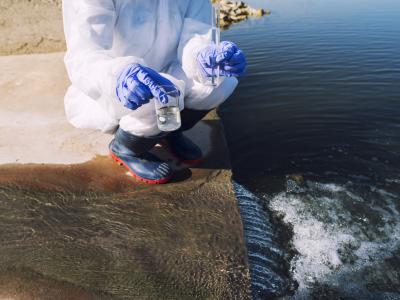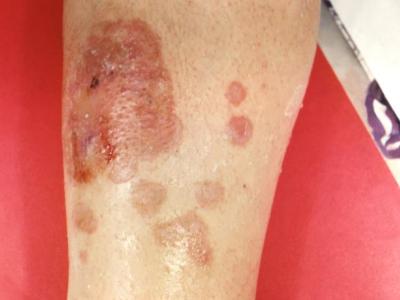Study: Low-dose, natural-route Ebola fails to cause disease in macaques
Low doses of the Makona strain of Ebola failed to cause disease, tissue lesions, or high viral titers in macaques when administered via the mouth or eye, according to a study yesterday in the Journal of Infectious Disease.
The Zaire ebolavirus Makona strain, which was implicated in the recent West African outbreak, has proved lethal in nonhuman primates at low doses when administered via parenteral or aerosol routes. Galveston National Laboratory researchers infected six cynomolgus macaques with the Makona strain via the oropharynx and conjunctiva to examine the effect of different doses on more natural routes of infection.
Four macaques that received 10 plaque-forming units (PFUs) of Ebola through these routes failed to develop clinical disease, the authors said. The monkeys also had no changes in hematologic or serum tests, no detectable virus in plasma or viral RNA in whole blood, and no lesions or viral antigen in tissues. All swab samples except one tested negative, though researchers were unable to isolate infectious virus from the macaque with the positive test.
One macaque who received a high oral dose (100 PFUs) of the Makona strain became ill 7 days after exposure and had a high level of viremia at day 5. At necropsy, the monkey had viral antigen in tissue and lesions on the lymph nodes, spleen, and liver consistent with Ebola infection.
The macaque who received 100 PFUs via the conjunctiva had no evidence of illness, except for lymphopenia and anorexia, and survived until the end of the study. The monkey had low-level viremia 2 weeks after exposure, viral RNA in nasal swabs at day 7, no tissue lesions, and weak antigen levels in the spleen and lymph nodes, the authors said.
The threshold of the Makona strain's lethality may be more than 10-fold higher via more natural routes of infection than by the parenteral or aerosol pathways, the authors said, noting that their results cannot be generalized to other Ebola strains.
Jun 9 J Infect Dis study
Wisconsin reports 2 more cases of Elizabethkingia infection
Two new cases of Elizabethkingia infection were reported Jun 7 by the Wisconsin Department of Health Services (WDHS), one of them a case previously counted as under investigation, according to a story yesterday in the Milwaukee Journal Sentinel.
The two cases bring the total in Wisconsin since the outbreak began late last year to 67, with 17 deaths. The total includes 4 confirmed cases that are not tied definitively to the outbreak because the strain could not be identified. In addition, Michigan and Illinois have each reported 1 fatal case.
The case-patients have commonly had underlying medical conditions and most have been older than 65 years of age. It has not been determined whether the deaths were attributable to the infection or to preexisting conditions. No source of the infection has been identified, but the investigation continues.
Elizabethkingia bacteria are common in soil, water, and throughout the environment and rarely cause illness. Symptoms of infection include fever, shortness of breath, chills, and cellulitis. The infection is resistant to numerous antibiotics.
Jun 8 Journal Sentinel article
WDHS Elizabethkingia page
Most recent (Apr 29) CIDRAP News item on Elizabethkingia
Study: More than a third of early Abu Dhabi MERS cases were asymptomatic
A substantial portion of MERS-CoV cases in Abu Dhabi have been asymptomatic and have shown a long duration of positivity on testing, underlining the importance of wide surveillance, according to a 2013-14 study published yesterday in Emerging Infectious Diseases.
Researchers led by Health Authority–Abu Dhabi and the Centers for Disease Control and Prevention (CDC) evaluated laboratory and surveillance data for 65 confirmed MERS-CoV (Middle East respiratory syndrome coronavirus) cases from Jan 1, 2013, to May 9, 2014.
More than a third (23, or 35%) had asymptomatic infections. Similar to previous study findings, case-patients who tested positive during the 17 months were more likely to be male (43, or 66%) and between the ages of 20 and 59 (51, or 78%), although severe cases were more common in older patients.
The majority of positive test results came from lower respiratory tract (RT) specimens (249 of 297 samples, or 84%), and 34% of lower RT samples were positive 14 days or longer after the initial test, in comparison with 13% of upper RT specimens, the authors said. Fifteen patients had positive test results for more than 2 weeks, including one who was asymptomatic, and four people tested positive for more than 3 weeks, including three who had mild symptoms.
A significant proportion of cases (42%) were associated with healthcare settings and included 31 healthcare workers, 12 (39%) of whom were asymptomatic. Eight of the 65 total patients died from their infections, the authors said.
The significant number of asymptomatic and mild MERS infections raises questions about the potential for viral shedding and disease spread in Abu Dhabi's population of 2.3 million, the authors noted. The country's surveillance system for MERS-CoV includes screening of both symptomatic and asymptomatic contacts of case-patients and collecting detailed epidemiologic data.
Jun 9 Emerg Infect Dis study
H5N1 outbreak hits birds in Nigeria's Abuja region
Nigerian government officials have responded to another outbreak of highly pathogenic H5N1 avian flu at a backyard farm in the Federal Capital Territory, according to a report yesterday to the World Organization for Animal Health (OIE).
The affected facility is near the capital city of Abuja in central Nigeria. The outbreak, which began Jun 3, killed 40 of 400 layers, the report said. The remaining birds were culled to stop the virus's spread.
Nigeria has been battling a string of H5N1 outbreaks since last September. As in many previous reports to the OIE, officials said that poor farm biosecurity contributed to the problem.
Jun 9 OIE report










